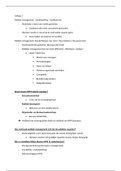1.
Alvesson (2013: 3-4) defines the concept of ‘organizational culture’ by listing how ‘the diverse perspectives surveyed here (…) share assumptions about cultural phenomena’ (2013: 3). He lists five assumptions. Name four of them.
Antwoord: 1. They are related to history and tradition
2. They have some depth, are difficult to grasp and account for and must be interpreted
3. They are collective and shared by members of groups
4. They are primarily ideational in character, having to do with meaning, understanding, beliefs, knowledge and other intangibles.
5. They are holistic, intersubjective and emotional rather than strictly rational and analytical.




